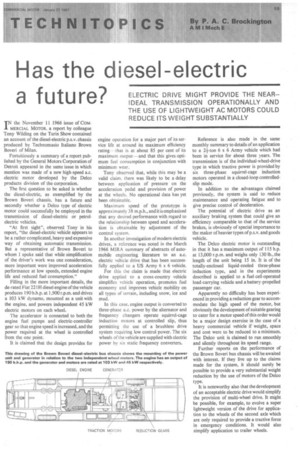Has the diesel-electric a future?
Page 61

If you've noticed an error in this article please click here to report it so we can fix it.
ELECTRIC DRIVE MIGHT PROVIDE THE NEAR— IDEAL TRANSMISSION OPERATIONALLY AND THE USE OF LIGHTWEIGHT AC MOTORS COULD REDUCE ITS WEIGHT SUBSTANTIALLY
TN the November 11 1966 issue of COMA. MERCIAL MOTOR, a report by colleague Tony Wilding on the Turin Show contained an account of the diesel-electric p.s.v. chassis produced by Technomasio Italian° Brown Boveri of Milan.
Fortuitiously a summary of a report published by the General Motors Corporation of Detroit appeared in the same issue in which mention was made of a new high-speed a.c. electric motor developed by the Delco products division of the corporation.
• The first question to be asked is whether the diesel-electric, as exemplified by the Brown Boveri chassis, has a future and secondly whether a Delco type of electric motor could successfully be employed in the transmission of diesel-electric or petrolelectric vehicles.
"At first sight" observed Tony in his report, "the diesel-electric vehicle appears to be a rather complicated, heavy and expensive way of obtaining automatic transmission. But a representative of Brown Boveri to whom I spoke said that while simplification of the driver's work was one consideration, more important were improved acceleration performance at low speeds, extended engine life and reduced fuel consumption."
Filling in the more important details, the de-rated Fiat 221H diesel engine of the vehicle produces 190 b.h.p. at 1,900 r.p.m. and drives a 103 kW dynamo, mounted as a unit with the engine, and powers independent 45 kW electric motors on each wheel.
The accelerator is connected to both the engine fuel pumps and electric-controller gear so that engine speed is increased, and the power required at the wheel is controlled from the one point.
It is claimed that the design provides for engine operation for a major part of its service life at around its maximum efficiency rating—that is at about 85 per cent of its maximum output—and that this gives optimum fuel consumption in conjunction with minimum wear.
Tony observed that, while this may be a valid claim, there was likely to be a delay between application of pressure on the acceleration pedal and provision of power at the wheels. No operational data has yet been obtainable.
Maximum speed of the prototype is approximately 38 m.p.h., and it is emphasized that any desired performance with regard to the relationship between speed and acceleration is obtainable by adjustment of the control system.
In another investigation of modern electric drives, a reference was noted in the March 1966 MIRA summary of abstracts of automobile engineering literature to an a.c. electric vehicle drive that has been successfully applied to a US Army 6 x 6 vehicle.
For this the claim is made that electric drive applied to a cross-country vehicle simplifies vehicle operation, promotes fuel economy and improves vehicle mobility on all types of terrain, including snow, ice and mud.
In this case, engine output is converted to three-phase a.c. power by the alternator and frequency changers operate squirrel-cage induction motors at controlled slip, thus permitting the use of a brushless drive system requiring low control power. The six wheels of the vehicle are supplied with electric power by six static frequency converters. Reference is also made in the same monthly summary to details of an application to a 24--ton 6 x 6 Army vehicle which had been in service for about three years. The transmission is of the individual-wheel-drive type in which tractive power is provided by six three-phase squirrel-cage induction motors operated in a closed-loop controlledslip mode.
In addition to the advantages claimed previously, the system is said to reduce maintenance and operating fatigue and to give precise control of deceleration.
The potential of electric drive as an auxiliary braking system that could give an efficiency comparable to that of the service brakes, is obviously of special importance to the maker of heavier types of p.s.v. and goods vehicle.
The Delco electric motor is outstanding in that it has a maximum output of 115 h.p. at 13,000 r.p.m. and weighs only 130 lb., the length of the unit being 15 in. It is of the totally-enclosed liquid-cooled three-phase induction type, and in the experiments described is applied to a fuel-cell-operated load carryingvehicle and a battery-propelled passenger car.
Apparently no difficulty has been experienced in providing a reduction gear to accommodate the high speed of the motor, but obviously the development of suitable gearing to cater for a motor speed of this order would be a major design exercise in the case of a heavy commercial vehicle if weight, space and cost were to be reduced to a minimum. The Delco unit is claimed to run smoothly and silently throughout its speed range.
Further reports on the performance of the Brown Boveri bus chassis will be awaited with interest. If they live up to the claims made for the system, it should surely be possible to provide a very substantial weight reduction by the use of motors of the Delco type.
It is noteworthy also that the development of an acceptable electric drive would simplify the provision of multi-wheel drive. It might be possible, for example, to evolve a super lightweight version of the drive for application to the wheels of the second axle which are only required to provide a tractive force in emergency conditions. It would also simplify application to trailer wheels.












































































































